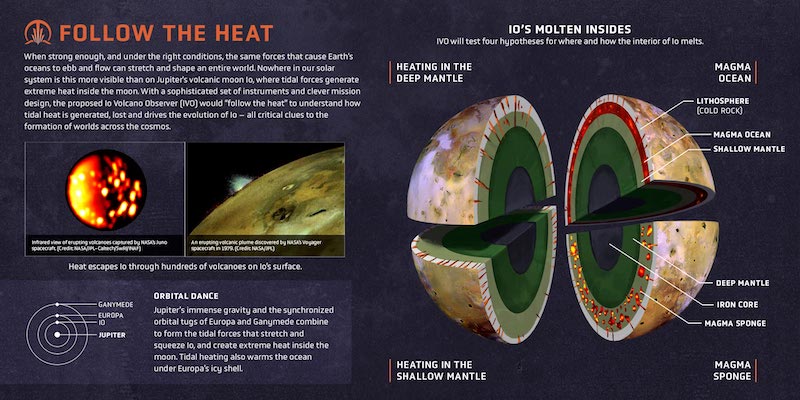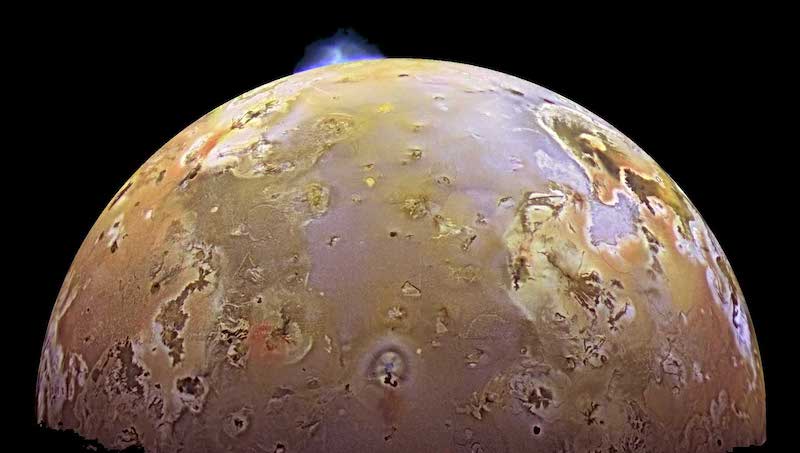
Io is a volcanic powerhouse
Jupiter’s moon Io is famous for its hundreds of active volcanoes. It looks like no other moon or planet in the solar system. Now, scientists say that Io’s uniqueness may run much deeper, with a subsurface ocean of magma or a solid core of hot metal. Researchers from NASA’s Jet Propulsion Laboratory (JPL) and the California Institute of Technology (Caltech) presented these findings from two new papers at the American Geophysical Union Fall Meeting (AGU22) in Chicago on December 15, 2022.
Io is not only volcanically active, it is the most volcanically active place in the solar system. Yes, even more than Earth. Its surface is covered by lakes of lava and sulphur deposits, giving it its uniquely colorful and mottled appearance. Some people call Io the “pizza moon” for this reason.
The researchers published the first peer-reviewed paper in the Bulletin of the American Astronomical Society, Vol. 54, No. 8 (December 2022), for the AAS Division of Planetary Science meeting #54. They published the second paper for the 16th Europlanet Science Congress 2022 (EPSC2022) in Granada, Spain (September 18-23, 2022). Abstracts and information from both papers were provided at the AGU22 fall meeting.
The second paper also studies the composition and geological activity of the other three Galilean moons of Jupiter as well: Europa, Ganymede and Callisto.
Subsequently, Nikk Ogasa wrote about the intriguing results for Science News on December 22, 2022.
Does Io have a subsurface magma ocean?
Scientists are still trying to determine just what drives Io’s intense volcanism. A gravitational tug-of-war between Jupiter and the moon Europa pulls and squeezes Io in the process. This creates frictional heat in Io’s interior. However, scientists aren’t sure how that heat is stored or moves around inside Io.
Planetary scientist Samuel Howell of the Jet Propulsion Laboratory at Caltech, and lead author of the second paper, stated in Science News:
It’s the most volcanically active place in the solar system. But it’s not really clear where that energy comes from.
A leading hypothesis is that there is a global ocean of hot magma below Io’s surface. It would be somewhat akin to the water oceans on Europa or Enceladus, for example. Except in this case, it’s hot, liquid magma. If it is there, it is likely quite deep. Planetary scientist David Stevenson of Caltech, one of two authors of the first paper, said:
The magma ocean could be, say, 100 kilometers [62 miles] thick.

Previous observations from Galileo
Previous evidence from NASA’s Galileo spacecraft also supported the possibility of a magma ocean. Galileo conducted magnetic measurements of Io’s interior and found that it contains a magnetically conductive layer. One study published in 2011 suggested the presence of a magma ocean beneath the surface.
There was, however, uncertainty as to whether it was really a global layer of magma or smaller pockets of magma within harder rock. The researchers refer to the magma pockets as a magmatic sponge. Stevenson and his colleague geophysicist Yoshinori Miyazaki, also at Caltech, say that this combination of solid rock and magma pockets would be too unstable, however. Due to the amount of heat present, the magma and solid rock would split into layers. The magma would be the bottom layer, and global. The paper explains:
Our results show that the predicted rate of tidal dissipation within Io is insufficient to sustain a partial melt layer that is consistent with the magnetometer data for a wide range of parameters. This indicates that a high-melt fraction layer would swiftly separate into two phases, resulting in a magma ocean. Unless melt and/or solid viscosities are in the higher end of the plausible range, a magmatic sponge would be unstable, and thus a high melt fraction layer suggested in Khurana et al. is likely to be a subsurface magma ocean.
And as Stevenson noted:
The final conclusion is [that] Io has a magma ocean.

Or does Io have a core of solid metal?
The researchers of the second paper, however, say there might be a different explanation. While the data largely fits with a magma ocean, this isn’t entirely agreed upon yet. Science News quoted Howell as saying:
A lot of information is consistent with a large, global conductive layer that could be a magma ocean. But I wouldn’t say there’s consensus on how to interpret that data.
Instead, Howell proposes a solid hot metal core inside Io. To explain the data, the core could be as rigid as solid ice, with a viscous mantle of rock above it. This could also effectively disperse the heat inside Io, the researchers say.
Additional observations
So which interpretation of Io’s interior is correct? Additional observations from NASA’s Juno spacecraft will be required to make that determination. It’s even possible that the answer might be a combination of both. The upcoming Europa Clipper and JUICE (Jupiter Icy Moons Explorer) missions may also be able to shed more light on what is happening inside this hellish but fascinating world.
Bottom line: Two new research papers debate whether Jupiter’s moon Io has a magma ocean or a hot metal core. The results were presented at the American Geophysical Union Fall Meeting (AGU22) earlier this month.
Sources:
AGU22: The possibility of a subsurface magma ocean on Io











